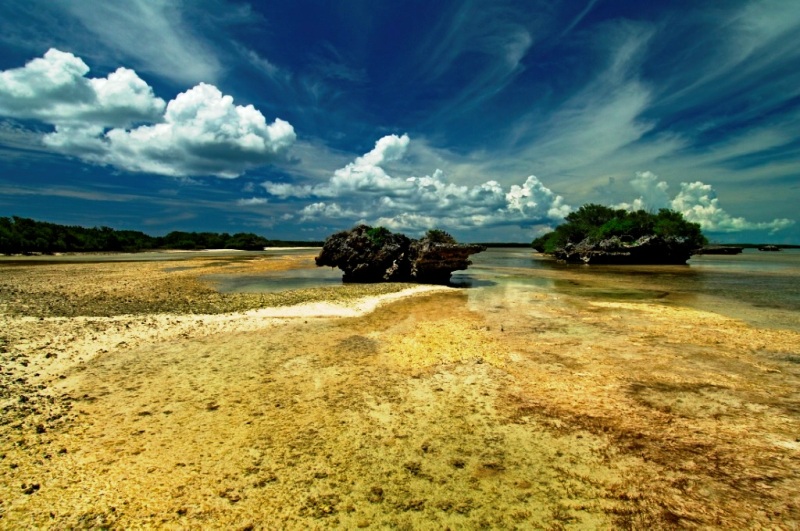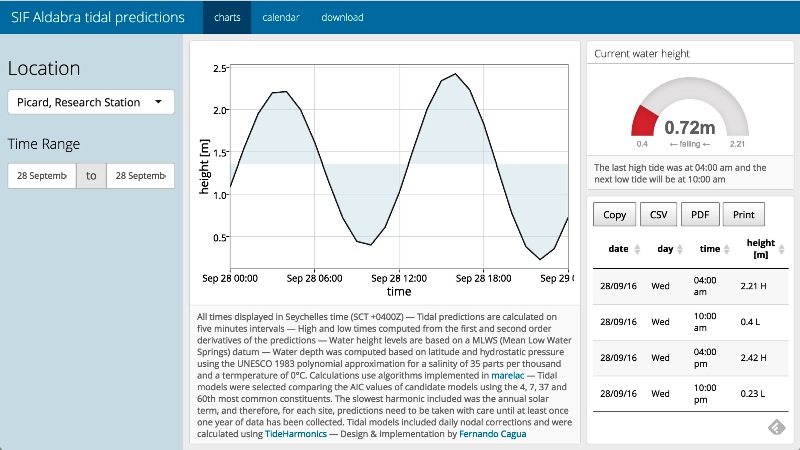New tidal app makes planning much easier on Aldabra |14 November 2016

Aldabra’s tide tables have, for a long time, been dependent on data collected elsewhere in the region, a situation which is far from ideal where tides dictate all life on the atoll. Aldabra has foiled several attempts to collect local tidal data but, since the installation of a new tidal gauge in 2015 and now with a year’s worth of data, a new model for the tidal range of Aldabra has been developed.
The power of the ocean is clearly seen in the daily tides of Aldabra. These tides shape the atoll’s coastal biodiversity and influence the behaviour of millions of marine organisms. In every ebb and flow of Aldabra’s tide, more than 100 million m3 of water flow in and out of its lagoon, which is enough to fill one swimming pool for every person in Seychelles and have some left over! As any seasoned sailor knows, tides dictate local currents and the times at which coastal navigation is possible. This has a significant effect on the research and monitoring programme at Aldabra so accurate predictions of the tidal pattern are essential.
Despite their significance, measuring and predicting tides is not straightforward. Tides are caused by the changes in the gravitational forces that the moon and sun exert on the earth. The earth completes one spin on its axis every 24 hours and the moon orbits the earth once every 25 hours, which is why we see a high and a low tide roughly every 12 hours. Further complications stem from the distances between the moon, sun and Earth not being constant and the fact that the Earth is tilted on its axis. The underlying topography of the ocean can also drive tidal currents and fluctuations. All these factors explain why some months have particularly high or low tides, and also why at some latitudes tidal changes are seen only every 24 hours instead of 12.
Aldabra has a large tidal range and a semi-diurnal tide system which means it experiences two high and two low tides of approx. equal size every day. Each month there are two extra-high spring tides which occur when the sun, moon and Earth are in alignment at the time of a new or full moon. For many years the Aldabra research station has used tidal charts from Mayotte as there were none available specifically for Aldabra. The tidal gauge installed in May 2015 on Aldabra’s outer reef precisely measures the distance between the sea floor and the ocean’s surface. With over a year’s data now collected, one of our research volunteers, Fernando Cagua, has constructed a tidal model and online app that allows us to predict the local tides with a much higher accuracy. This app will make it much easier to plan research activities on Aldabra and understand how Aldabra’s fauna is influenced by the tides.
Aldabra’s subsistence fishing activities reviewed

With its isolated location and hostile environment, Aldabra’s productive waters and associated fish communities have historically been protected from the degradation associated with high fishing pressure that has impacted many reefs throughout the Indian Ocean. In its 2015 report to the Government of Seychelles, the National Geographic Pristine Seas team estimated fish biomass in the near shore waters surrounding Aldabra to be 5 tonnes per hectare, more than ten times the fish biomass found in the Seychelles inner islands. Aldabra’s abundant and diverse fish life is a fantastic example of the structural complexity of a near-pristine marine ecosystem, with species from all trophic levels represented as well as some of the highest apex predator biomass found in the Western Indian Ocean.
Aldabra’s small subsistence fishery has supported the SIF research station for the past four decades. Fishing takes place with baited hand lines or lines trolled at low speeds behind a boat. No trapping, shore or spear fishing takes place to avoid targeting the herbivorous species that are crucial for reef health. Fishing is not permitted by anybody not working for SIF on Aldabra. The monitoring and management of the fishery is tightly controlled to ensure that these practices are sustainable and remain in keeping with Aldabra’s unique values and protected status.
The subsistence fishing activity has been the subject of a review over the past few months in tandem with the development of Aldabra’s new management plan. Part of this new management plan is to introduce a zoning system to the protected waters of Aldabra with designated fishing areas known as ‘Food Security Zones’. All other areas will then be categorised as No Take Zones. This will provide areas for the large, long-lived, slow-growing species that are at risk from even very low fishing pressure. During the review, the monitoring methodology has been updated by research volunteer Rosie Gordon, and a new automated on-board data collection app and database have been developed to facilitate data collection, and enable immediate analysis of any changes and trends in Aldabra’s subsistence fishery.
SIF remains committed to ensuring that Aldabra’s subsistence fishery has as little impact as possible on Aldabra’s marine ecosystem. This review is just one of the measures taken to ensure that management practices are continually reviewed and adapted to attain this objective.


Contributed by the Seychelles Islands Foundation (SIF)




